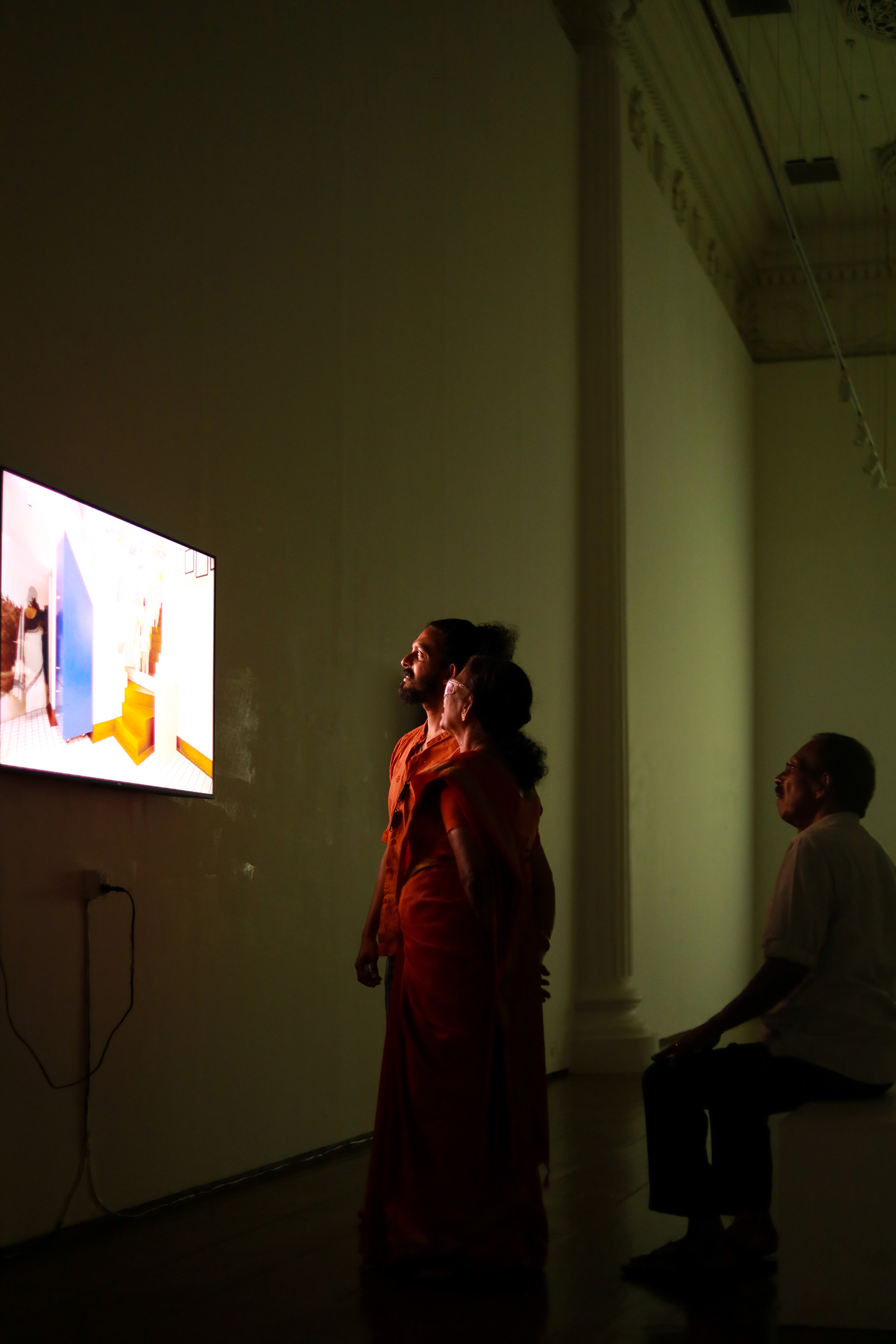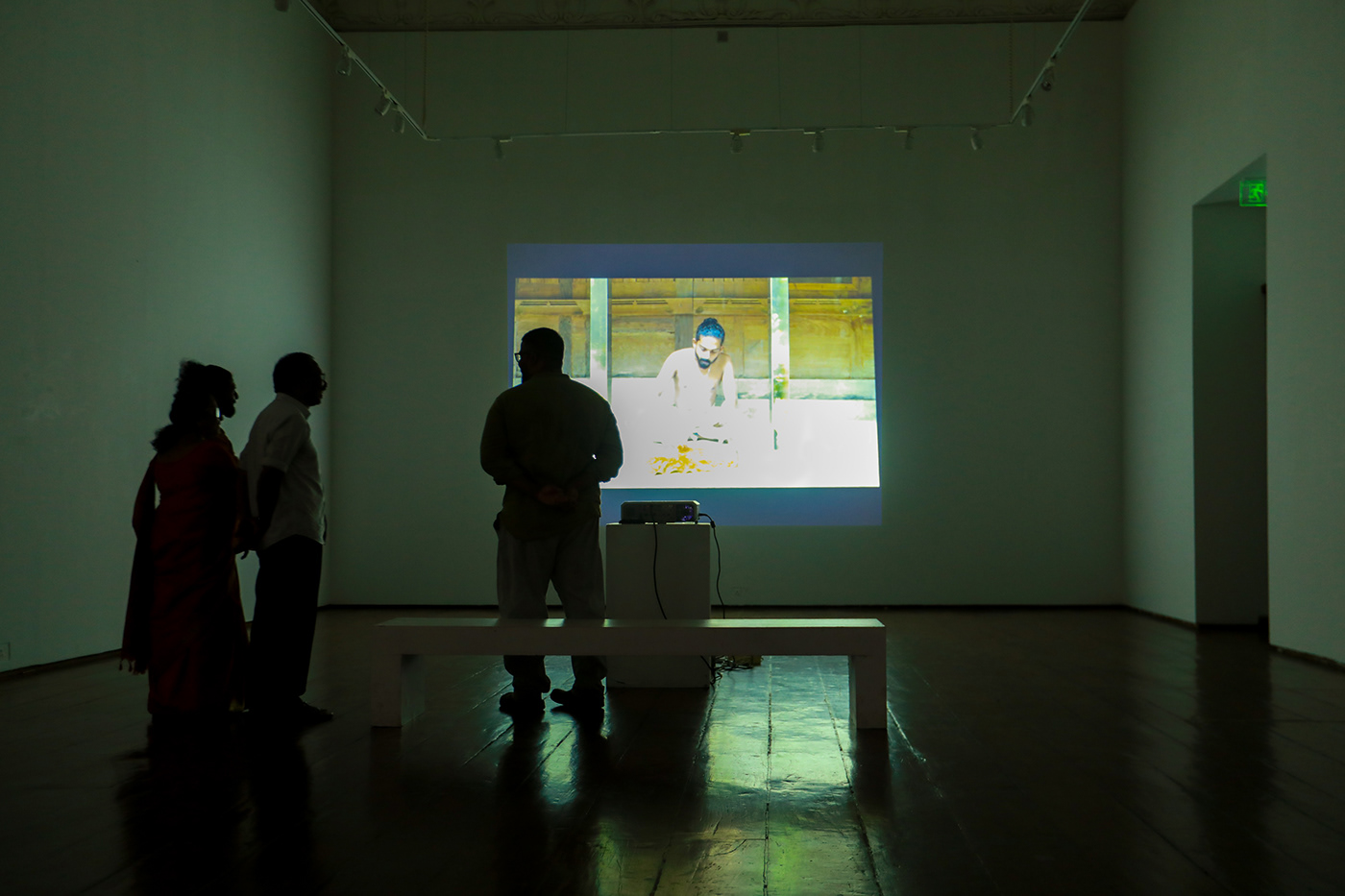


















Suspended Realities
Curated by: Bipin Balachandran
The significance of Anoop P. Rajendran’s art practice in the present scenario of visual art in Kerala lies in his role as an exponent of an emerging aesthetic sensibility. Notably, this artistic paradigm gains prominence in the context of the burgeoning popularity of digital media, an arena that, despite its momentum, witnesses a paucity of serious experimentation within the domain of visual arts. Anoop’s distinctiveness becomes apparent, given his divergence from a conventional art education, relying instead on his architectural background to inform his aesthetic sensibilities and guide his ventures into the realm of new media installations. The absence of formal artistic training, juxtaposed with his architectural acumen, affords Anoop a unique vantage point. In his video art, Anoop predominantly employs architectural elements as backdrops, demonstrating a recurrent integration of these elements into his visual compositions. This recurrent practice underscores the symbiotic relationship between architectural designing and the digital arts, further shaping the evolution of his innovative visual style. In doing so, Anoop not only charts the contours of a novel artistic sensibility but also engages in a profound act of political significance. His creative endeavors transcend the conventional boundaries of artistic expression; they become a manifestation of a robust political stance. Here, Ranciere’s juxtaposition of aesthetics and politics gains pertinence in the discourse surrounding Anoop’s artistic praxis. The very act of forging a new aesthetic sensibility is posited as inherently political—a transformative gesture that disrupts existing norms and challenges established paradigms. In Rancière's notion aesthetics and politics are intertwined through the notion of dissensus, where the reordering of the sensible gives rise to political subjectivity and transformation.
Anoop’s artistic practice can be thoroughly examined within the framework of critical theories, where his engagement with politics in art takes the form of a nuanced exploration of ideological dichotomies. Grounded in the tensions inherent in binaries like individual-society, labor-leisure, tradition-modernity, and faith-reason, Anoop's body of works stands as a compelling testament to the visual arts' ability to navigate intricate socio-cultural dynamics. Central to the effectiveness of Anoop's artistic expression is his skilled deployment of a narrative approach, emphasizing the medium of video art. This is notably exemplified in his recent project, consisting of multiple screens, where his inclination towards a narrative style, often described as 'cinematic,' becomes apparent. Here, the term 'cinematic' denotes an approach that draws from the conventions and techniques of filmmaking, involving visual storytelling, sequencing, and framing. Anoop's utilization of this narrative style extends beyond a mere chronological presentation; it involves a deliberate orchestration of visual elements across multiple screens, creating a dynamic and immersive experience for the audience. Through deft manipulation of elements such as movement, repetition, and editing, Anoop’s visual compositions not only capture the intricacies of societal tensions but elevate them to a realm of imaginative contemplation. This imaginative portrayal is hilariously characterized, lending a distinctive quality to his artistic discourse. Through the infusion of humor and a creative perspective into his works, Anoop accomplishes more than portraying ideological conflicts; he encourages viewers to engage in reflection and question prevailing socio-cultural paradigms. In doing so, he contributes to a broader discourse on the intersections of art, ideology, and societal dynamics.
Alienation and Power dynamics
Anoop’s art delves into the alienation experienced by the modern individual and the dynamic transformations in power structures, offering a profound examination of contemporary societal intricacies. He contends that, in a modern secular society, belief systems (of the pre-modern period) should retreat to the private sphere of the individual, even as they undergo periodic evolution. However, he discerns the impracticality of achieving a fully egalitarian society, recognizing it as a utopian ideal. His nuanced observation suggests the awareness that, despite transformative movements throughout history, the manifestations of societal inequities endure in varied and evolving forms. This recognition prompts a critical examination of the complexities inherent in attaining true societal equality, inciting contemplation on the enduring challenges faced by contemporary societies in mitigating oppression and alienation. In one of his works he employs the metaphor of ‘pickle’ to articulate his political stance, wherein tradition is preserved in the intimate confines of personal domains. However, a critical scrutiny reveals a lacuna in Anoop's perspective, as he appears to overlook the fact that the very notion of private space is a modern construct. This critique contends that the relegation of belief systems to private realms is, in essence, an application of the individualism engendered by modernity. The contemporary notion of private space emerges as a manifestation of the individualistic ethos ingrained in societal structures. Alternatively, it posits that in modern society, there is no space designated as private without undergoing the legitimating process of the collective. Additionally, another aspect that has received less attention in Anoop's art discourse is the contention suggesting that the 'absolute individual' in the modern conceptualization is, to a significant extent, an abstraction. According to this argument, the subjectivity of the modern person is constructed from what can be described as "modern myths." In a discerning analysis, Anoop's art emerges as a visual representation of the anxieties inherent in the existence of the modern individual, ensconced within the 'suspended realities' engendered by the myths of modernity. Anoop's artistic endeavors serve as a contemplative exploration into the psychological and existential tribulations faced by individuals navigating the complex and often disorienting landscapes shaped by modern myths. These 'suspended realities' encapsulate the paradoxes, uncertainties, and internal conflicts that characterize the contemporary human experience.
It appears that the acknowledgment of the role played by 'modern myths' in shaping the subjectivity of the modern individual could have rendered Anoop's position more encompassing. Recognition of these pervasive cultural narratives would potentially enrich Anoop's perspective, fostering a broader understanding of the intricate interplay between individual identity and the influential mythic constructs (both traditional and modern) prevalent in contemporary society. In adopting a more inclusive perspective, one might argue that the relegation of belief systems to private spaces is not merely a consequence of secularism but also a reflection of the broader transformations in the understanding of the individual within the modern paradigm. Anoop's metaphorical use of pickle could then be seen as emblematic of the delicate balance with which modern individuals tread between tradition and the evolving narratives of selfhood.
